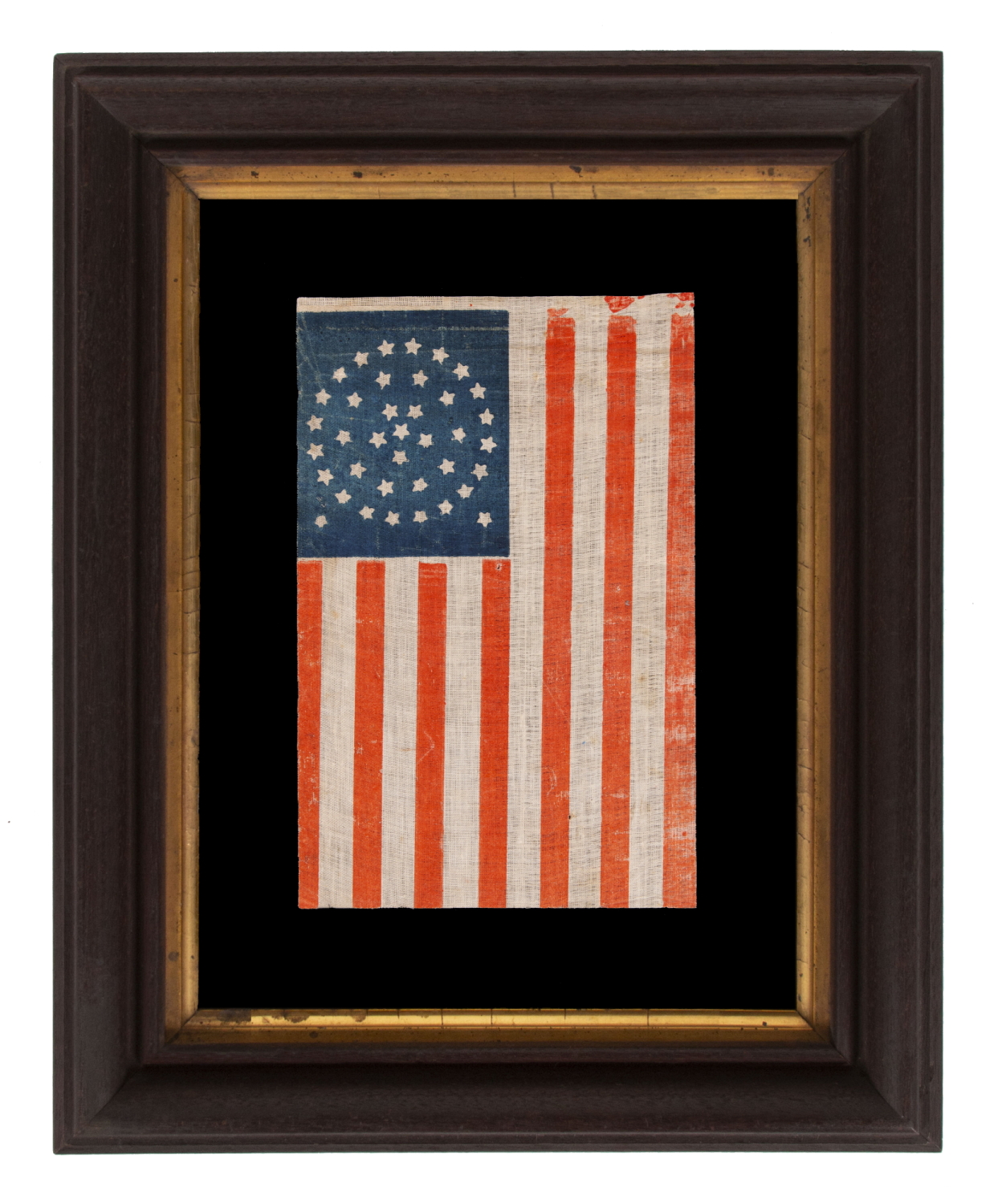
| |
38 STARS IN A TRIPLE WREATH STYLE MEDALLION CONFIGURATION, WITH 2 OUTLIERS, ON ANTIQUE AMERICAN PARADE FLAG WITH BEAUTIFUL COLOR, MADE IN THE ERA WHEN COLORADO WAS THE MOST RECENT STATE TO JOIN THE UNION, 1876-1889 |
|
| Available: |
Sold |
| Frame Size (H x L): |
Approx. 17.5" x 14.5" |
| Flag Size (H x L): |
9" x 6" |
|
| Description....: |
|
38 star American parade flag, block-printed by hand on coarse, glazed cotton. The stars are arranged in a triple-wreath form of the medallion configuration, with a single center star and two stars flanking outside the basic pattern toward the fly end. Most circular medallion patterns exhibit four flanking stars beyond the consecutive wreaths, one in each corner. The inclusion of only two was intentional, allowing for the easy addition of two more stars. Flag-makers knew that more Western Territories were soon to be added and eagerly anticipated their arrival. Use of fewer than four outliers was popular in 38 star parade flags, but is rarely encountered in other star counts.
Most parade flags in this star count have red stripes that lean heavily toward orange, with a vibrant, chromatic luster, as-is the case here. This was common across printed flags produced between the 1850's and the 38 star period, phasing out in the last decade of the 19th century.
Colorado became the 38th state on August 1st, 1876. This was the year of our nation’s 100-year anniversary of independence. Per the Third Flag Act of 1818, stars were not officially added until the 4th of July following a state's addition. For this reason, 37 was the official star count for the American flag in 1876. Flag-making was a competitive venture, however, and few flag-makers would have been continuing to produce 37 star flags when their competitors were making 38’s. It is for this reason that 38 and 13 stars (to represent the original 13 colonies) are more often seen at the Centennial International Exposition, the six-month long World’s Fair held in Philadelphia in honor of the event.
Some flag-makers would have been adding a star for the 38th state even before it entered the Union, in the early part of 1876 or even prior. In fact, many makers of parade flags were actually producing 39 star flags, in hopeful anticipation of the addition of two more Western Territories instead of one. But the 39th state would not join the Union for another 13 years, when the Dakota Territory entered as two states on the same day. The 38 star flag generally fell from use at that time, though it technically remained official until July 3rd, 1890.
President Ulysses S. Grant was in office when the first 38 star flags would have appeared. The list of presidents serving during the period when the 38 star flag was actually official, include Rutherford B. Hayes, James Garfield, Chester Arthur, Grover Cleveland, and Benjamin Harrison.
Mounting: The flag was mounted and framed within our own conservation department, that is led by expert staff. We take great care in the mounting and preservation of flags and have framed thousands of examples.
The antique, solid walnut molding dates to the same period as the flag, retains its original patina—nearly black—as well as its original gilded liner. The flag has been hand-stitched to a background of 100% cotton twill, black in color, that was washed and treated for colorfastness. The glazing is U.V. protective acrylic (Plexiglas).
Condition: There is minor misprinting along the hoist, adjacent to the 6th and 7th red-orange stripes. There are pinprick-sized holes in the 4th red stripe, adjacent to the canton, and between the 9th and 10th stripes. There is some pigment loss, most notably in the upper, fly end quadrant of the canton, and along narrow vertical folds near the hoist end, accompanied by some of the same in the red-orange stripes, in limited areas, most notably in the last stripe, and to a lesser degree in the two above it. There is a narrow strip of fabric loss in the white area along the hoist, running about ¾ of the height of the canton, from the top down. This was restored with a small piece of period parade flag fabric, from another 38 star example. Many of my clients prefer early flags to show their age and history of use. |
|
|
|
| Collector Level: |
Intermediate-Level Collectors and Special Gifts |
|
| Flag Type: |
Parade flag |
|
| Star Count: |
38 |
|
| Earliest Date of Origin: |
1876 |
|
| Latest Date of Origin: |
1889 |
|
| State/Affiliation: |
Colorado |
|
| War Association: |
|
|
| Price: |
SOLD |
|
| |
Views: 943 |
|
|
|

